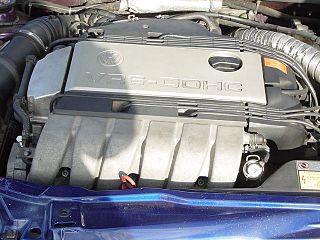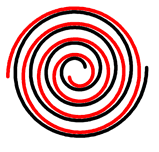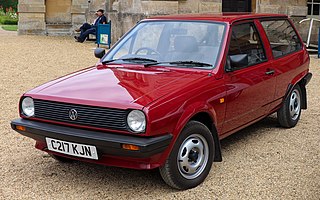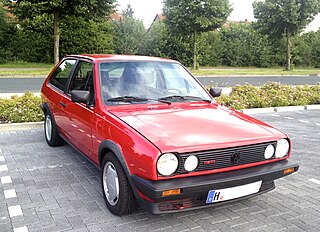
In an internal combustion engine, a turbocharger is a forced induction device that is powered by the flow of exhaust gases. It uses this energy to compress the intake air, forcing more air into the engine in order to produce more power for a given displacement.
A centrifugal supercharger is a specialized type of supercharger that makes use of centrifugal force in order to increase the manifold air pressure, MAP. An increased MAP allows the engine to burn more fuel, which results in an increased power output. Centrifugal superchargers are generally attached to the front of the engine via a belt-drive or gear-drive from the engine's crankshaft.

The Volkswagen Polo is a supermini car (B-segment) produced by the German car manufacturer Volkswagen since 1975. It is sold in Europe and other markets worldwide in hatchback, saloon, and estate variants throughout its production run.

The Volkswagen Corrado is a compact four passenger (2+2), three door, front-engine, front-wheel-drive liftback coupe marketed by Volkswagen from 1988 until 1995, and manufactured by Karmann in Osnabrück, Germany.

The Volkswagen Passat is a nameplate of large family cars (D-segment) manufactured and marketed by the German automobile manufacturer Volkswagen since 1973. It has been marketed variously as the Dasher, Santana, Quantum, Magotan, Corsar and Carat, with varying body styles such as saloon, estate, and hatchback.
The Volkswagen Group A platform is an automobile platform shared among compact and mid-size cars of the Volkswagen Group.

The VR6 engine is a six-cylinder engine configuration developed by VW. The name VR6 comes from the combination of German words “Verkürzt” and “Reihenmotor” meaning “shortened inline engine”. It was developed specifically for transverse engine installations and FWD vehicles. The VR6 is a highly compact engine, thanks to the narrower angle of 10.5 to 15 degrees between cylinder banks, as opposed to the traditional V6 angles ranging from 45 to 90 degrees. The compact design is cheaper to manufacture, since only one cylinder head is required for all six cylinders, much like a traditional inline-6 engine.
The Volkswagen Group B platform is a mid-size automobile platform from the Volkswagen Group. It has been used for saloon cars/sedans, estate cars/station wagon, and coupés - under the Volkswagen Passenger Cars, Audi, SEAT and Škoda marques.

The Volkswagen G60 and G40 were inline–four-cylinder automobile petrol engines, which used a specific method of forced induction by way of a scroll-type supercharger. The G60 engine was formerly manufactured by the German automaker Volkswagen Group and was installed in a limited number of their 'hot hatch' cars from their Volkswagen Passenger Cars marque from August 1988 to July 1993.

The scroll-type supercharger is a scroll compressor used as a positive displacement orbiting-spiral supercharger. It is a compromise between the more rugged rotating lobe, and the more efficient sliding vane type superchargers, and is considered to offer the highest potential in regard to efficiency, noise and pressure fluctuation.

The Volkswagen Polo Mk2 is the second generation of the Volkswagen Polo supermini. It was produced from late 1981 until 1994. It received a major facelift in 1990 and was available in three different body styles, including a distinctive kammback-styled hatchback, nicknamed "breadvan" in the UK but referred to as a Steilheck in Germany. The sedan version typically received the name of Volkswagen Derby.

The Volkswagen Golf Mk2 is a hatchback, the second generation of the Volkswagen Golf and the successor to the Volkswagen Golf Mk1. It was Volkswagen's highest volume seller from 1983 and ended in (German) production in late 1992, to be replaced by the Volkswagen Golf Mk3. The Mk2 was larger than the Mk1; its wheelbase grew slightly, as did exterior dimensions. Weight was up accordingly by about 120 kg (260 lb). Exterior design, developed in-house by VW design director Schäfer, kept the general lines of its Giugiaro-designed predecessor, but was slightly more rounded. All told, about 6.3 million second-generation Golfs were built.

The EA827 family of petrol engines was initially developed by Audi under Ludwig Kraus leadership and introduced in 1972 by the B1-series Audi 80, and went on to power many Volkswagen Group models, with later derivatives of the engine still in production into the 2010s. This is a very robust water-cooled engine configuration for four- up to eight- cylinders. In Brazil this engine was produced under the name Volkswagen AP AP.

The Volkswagen Polo Mk2 and Polo Mk2F were available as supercharged G40 models - called the Volkswagen Polo G40.

The third-generation Volkswagen Passat, known as Volkswagen Passat B3 or Volkswagen Passat 35i, was introduced in March 1988 in Europe, 1989 in North America, and 1995 in South America; it was also briefly available in Australia in 1991, when a total of 14 Passat GL 16V in sedan and wagon versions were sold by then importer TKM. Unlike the previous two generations of the Passat, the B3 was not available as a fastback - only 4-door sedan and 5-door station wagon versions were available, setting the precedent for the model for all subsequent generations to date. Its curvy looks were a contrast from the boxy appearance of its predecessor and owed much to the "jelly mould" style pioneered by Ford with the Sierra and Taurus. The lack of a grille, utilizing the bottom breather approach, made the car's front end styling reminiscent of older, rear-engined Volkswagens such as the 411, and also doubled as a modern styling trend. The styling was developed from the 1981 aerodynamic Auto 2000 concept car.














